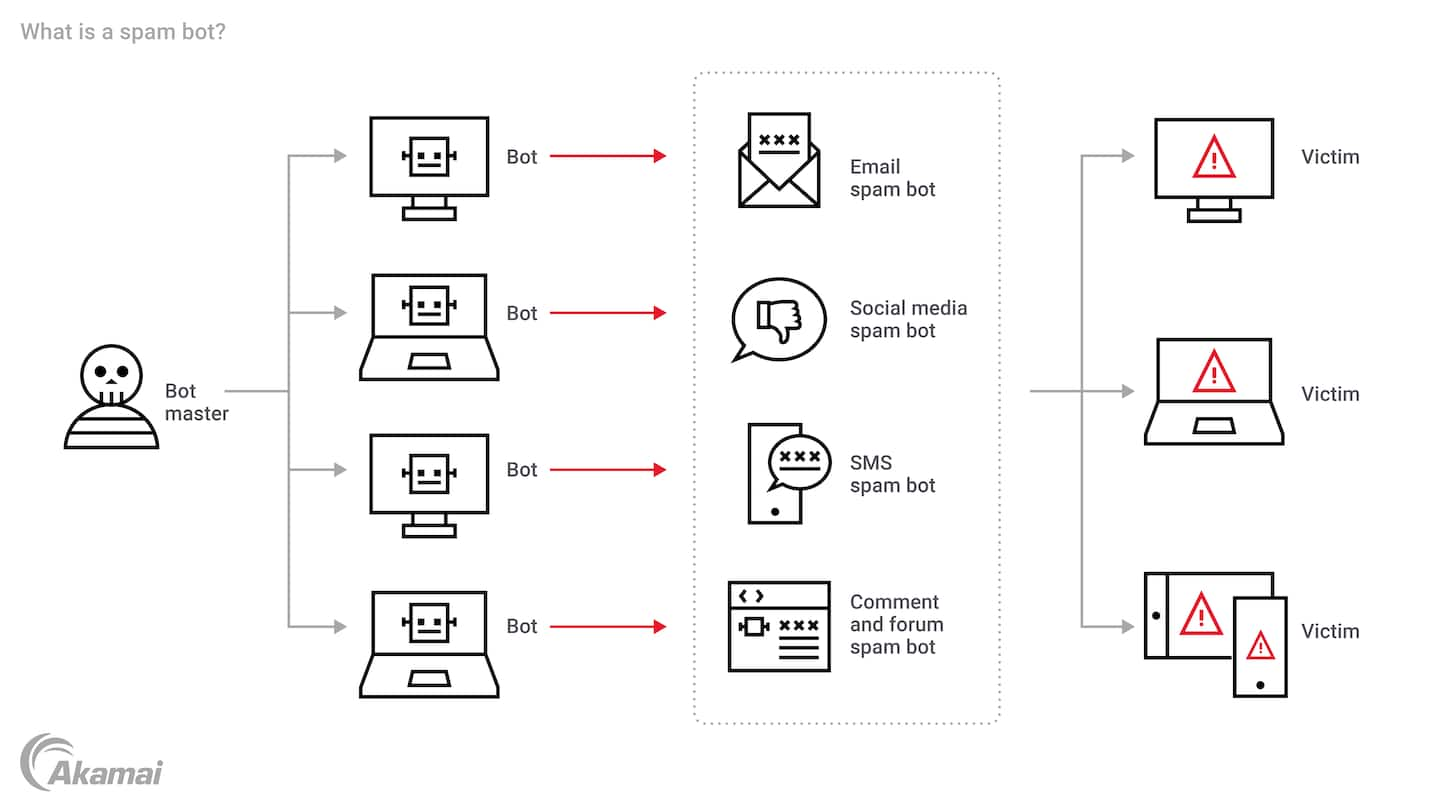Akamai is the cybersecurity and cloud computing company that powers and protects business online. Our market-leading security solutions, superior threat intelligence, and global operations team provide defense in depth to safeguard enterprise data and applications everywhere. Akamai’s full-stack cloud computing solutions deliver performance and affordability on the world’s most distributed platform. Global enterprises trust Akamai to provide the industry-leading reliability, scale, and expertise they need to grow their business with confidence.
A spam bot, or spambot, is a type of computer program that’s designed to generate and distribute spam messages and content. These may include unsolicited messages on various digital platforms, including email, online forums, social media, and web forms. Some spam messages contain annoying but innocuous content like unwanted product advertisements or irrelevant backlinks that help websites rank higher in search engines. At worst, spam messages may be part of scams or phishing attacks, or they may contain links to malicious content and to websites hosting malware and different types of ransomware. Detecting and blocking spam bots requires a diligent approach to bot management and security.
Types of spam bots
Bots are automated software programs built to perform highly repetitive tasks without intervention from human users. Good bots include technology like chatbots that perform customer service tasks and search engine crawlers that index web pages for Google and Bing. Bad bots help cybercriminals to steal data, access user accounts, perform click bot fraud, scrape content from websites without permission, perform distributed denial-of-service attacks, hoard inventory for ticket scalpers, and manipulate conversations on social media.
Falling in the category of “bad bots,” spam bots include several different kinds of bots.
- Email spam bots assist senders of email spam by creating fake accounts from which to send spam, harvesting email lists and addresses from the web, and sending spammy messages in bulk.
- Social media spam bots operate on social media platforms to post spam content, create fake accounts, and send unsolicited messages to social media users.
- SMS spam bots send spam messages to cell phone numbers collected from a variety of sources.
- Comment and forum spam bots automatically post spam comments in the comment sections of web forums and websites.
How do spam bots work?
Written in languages like JavaScript or CSS, spam bots gain access to various platforms by exploiting vulnerabilities in software, web pages, and messaging apps. Some bots evade detection by spoofing the IP address of actual users or creating fake accounts. Spam bots are also programmed to appear as if their actions are those of a real user.
Why spam bots are a problem
Spam bots have an adverse impact on businesses, websites, and users.
- Loss of productivity: Dealing with spam messages can consume a large amount of time and resources for a business’s employees.
- Poor network performance: The high volume of traffic generated by spam bots can potentially overwhelm a network and cause performance to suffer.
- User experiences: Spam bots can severely degrade the user experience on various platforms.
- Cyberattacks: Cybercriminals frequently use spam bots in efforts to distribute malware, in phishing attacks, and in DDoS campaigns that overload systems with bot activity.
- Disinformation: With the ability to post spam messages quickly and easily on thousands of accounts, malicious actors bent on creating disinformation may use spam bots to manipulate public opinion, undermine a company’s brand reputation, distort financial markets, interfere in elections, and create chaos online.
How to detect and prevent spam bots
Detecting spam bot activity requires monitoring solutions that can identify anomalous behavior in online traffic, including unusually high rates of submissions from a single IP address or behavior that suggests nonhuman interactions with web forms.
Web and security teams can use a variety of methods to prevent spam bots from causing harm.
- CAPTCHA technology presents challenges that are easy for real users to accomplish but hard for bots to manage.
- Honeypot fields are form fields that are invisible to real users but visible to bots. When a honeypot field is filled out, it indicates bot activity.
- Validation checks in bot management solutions can validate the information entered in web forms to ensure it meets human-centric criteria.
- Monitoring and blocking spam comments and posts in forums and comment sections can reduce spam and keep known spammers from accessing these web properties.
- Web application firewalls (WAF) can help to block spam bots by identifying potentially inauthentic behavior.
- Bot management solutions from leading security providers offer comprehensive bot management technology powered by AI and threat intelligence. These solutions offer automated, multilevel protection to defend against spam bots while minimizing the burden on security teams.
FAQs
While sophisticated spam bots can use machine learning to solve CAPTCHA challenges, this technique is still effective at deterring most spam bots.
A vast audience makes social media platforms attractive targets for spammers looking to scam users, distribute misinformation, or distribute malware.


